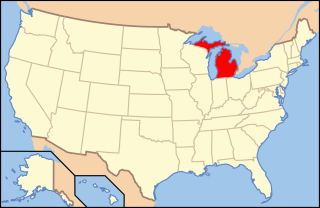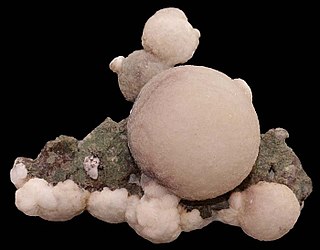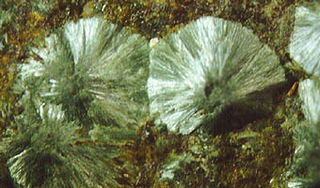Related Research Articles

Amethyst is a violet variety of quartz. The name comes from the Koine Greek αμέθυστος amethystos from α- a-, "not" and μεθύσκω methysko / μεθώ metho, "intoxicate", a reference to the belief that the stone protected its owner from drunkenness. The ancient Greeks wore amethyst and carved drinking vessels from it in the belief that it would prevent intoxication.

Isle Royale National Park is an American national park consisting of Isle Royale and hundreds of adjacent islands, as well as the surrounding waters of Lake Superior, in the state of Michigan. Isle Royale National Park was established on April 3, 1940, then additionally protected from development by wilderness area designation in 1976, and declared a UNESCO International Biosphere Reserve in 1980. The park covers 894 square miles (2,320 km2), with 209 square miles (540 km2) of land and 685 square miles (1,770 km2) of surrounding waters. The park's northern boundary lies adjacent to the Canadian Lake Superior National Marine Conservation Area along the international border.

Peridot ( or ) (sometimes called chrysolite) is gem-quality olivine and a silicate mineral with the formula of (Mg, Fe)2SiO4. As peridot is a magnesium-rich variety of olivine (forsterite), the formula approaches Mg2SiO4. Its green color is dependent on the iron contents within the structure of the gem. Peridot occurs in silica-deficient rocks such a volcanic basalt as well as in pallasitic meteorites. Peridot is one of only two gems observed to be formed not in the Earth’s crust, but in molten rock of the upper mantle. Gem-quality peridot is rare to find on Earth's surface due to its susceptibility to weathering during transportation from deep within the mantle to the surface.

Jasper, an aggregate of microgranular quartz and/or chalcedony and other mineral phases, is an opaque, impure variety of silica, usually red, yellow, brown or green in color; and rarely blue. The common red color is due to iron(III) inclusions. Jasper breaks with a smooth surface and is used for ornamentation or as a gemstone. It can be highly polished and is used for items such as vases, seals, and snuff boxes. The specific gravity of jasper is typically 2.5 to 2.9. A green variety with red spots, known as heliotrope (bloodstone), is one of the traditional birthstones for March. Jaspillite is a banded-iron-formation rock that often has distinctive bands of jasper.

The Keweenaw Peninsula is the northernmost part of Michigan's Upper Peninsula. It projects into Lake Superior and was the site of the first copper boom in the United States, leading to its moniker of "Copper Country." As of the 2000 census, its population was roughly 43,200. Its major industries are now logging and tourism, as well as jobs related to Michigan Technological University and Finlandia University.
Greenstone may refer to:

Isle Royale is an island of the Great Lakes, located in the northwest of Lake Superior, in Laurentia. It is part of the U.S. state of Michigan. The island and the 450 surrounding smaller islands and waters make up Isle Royale National Park.

The following is an alphabetical list of articles related to the U.S. state of Michigan.

Chrysocolla is a hydrated copper phyllosilicate mineral with formula Cu
2–xAl
x{H
2–xSi
2O
5)(OH)
4•nH
2O (x<1) or (Cu,Al)
2H
2Si
2O
5(OH)
4•nH
2O). The structure of the mineral has been questioned, as spectrographic studies suggest material identified as chrysocolla may be a mixture of the copper hydroxide spertiniite and chalcedony.

Tsavorite or tsavolite is a variety of the garnet group species grossular, a calcium-aluminium garnet with the formula Ca3Al2Si3O12. Trace amounts of vanadium or chromium provide the green color.

Sunstone is a plagioclase feldspar, which when viewed from certain directions exhibits a spangled appearance. It has been found in Southern Norway, Sweden, various United States localities and on some beaches along the midcoast of South Australia.

Thomsonite is the name of a series of tecto-silicate minerals of the zeolite group. Prior to 1997, thomsonite was recognized as a mineral species, but a reclassification in 1997 by the International Mineralogical Association changed it to a series name, with the mineral species being named thomsonite-Ca and thomsonite-Sr. Thomsonite-Ca, by far the more common of the two, is a hydrous sodium, calcium and aluminium silicate, NaCa2Al5Si5O20·6H2O. Strontium can substitute for the calcium and the appropriate species name depends on the dominant element. The species are visually indistinguishable and the series name thomsonite is used whenever testing has not been performed. Globally, thomsonite is one of the rarer zeolites.

Rock Harbor is the main access point for visitors landing on Isle Royale in northern Lake Superior. It sits four miles (6.4 km) from the northeastern end of the 45-mile-long (72 km) island, the whole of which is protected as Isle Royale National Park. Two structures in Rock Harbor—the Rock Harbor Light and the Edisen Fishery—are listed on the National Register of Historic Places.

Lake Duluth was a proglacial lake that formed in the Lake Superior drainage basin as the Laurentide Ice Sheet retreated. The oldest existing shorelines were formed after retreat from the Greatlakean advance, sometime around 11,000 years B.P. Lake Duluth formed at the western end of the Lake Superior basin. Lake Duluth overflowed south through outlets in Minnesota and Wisconsin at an elevation of around 331 m above sea level.

Lake Minong was a proglacial lake that formed in the Lake Superior basin during the Wisconsin glaciation around 10,000 B.P.. This was the last glacial advance that entered Michigan and covered only part of the upper peninsula. Lake Minong occurred in the eastern corner of the Lake Superior basin while Lake Duluth was in the western end. The lakes became separated when the glacier reached the upper peninsula. Lake Minong expanded to the north as the ice retreated after 9,800 B.P. When the ice retreated from the Keweenaw Peninsula, Lake Duluth merged into Lake Minong.

Pumpellyite is a group of closely related sorosilicate minerals:

Amygdaloid Island is an island in Lake Superior off the northeastern shore of Isle Royale. It is within the boundary of Isle Royale National Park, a national park located within the U.S. state of Michigan. The island is protected and patrolled by a seasonal ranger station operated by the U.S. National Park Service.

The Midcontinent Rift System (MRS) or Keweenawan Rift is a 2,000 km (1,200 mi) long geological rift in the center of the North American continent and south-central part of the North American plate. It formed when the continent's core, the North American craton, began to split apart during the Mesoproterozoic era of the Precambrian, about 1.1 billion years ago. The rift failed, leaving behind thick layers of igneous rock that are exposed in its northern reaches, but buried beneath later sedimentary formations along most of its western and eastern arms. Those arms meet at Lake Superior, which is contained within the rift valley. The lake's north shore in Ontario and Minnesota defines the northern arc of the rift. From the lake, the rift's eastern arm trends south to central lower Michigan, and possibly into Indiana, Ohio, Kentucky, Tennessee, and Alabama. The western arm runs from Lake Superior southwest through portions of Wisconsin, Minnesota, Iowa, and Nebraska to northeastern Kansas, and possibly into Oklahoma.

The Greenstone Ridge Trail is a 40-mile-long (64 km) hiking trail on Isle Royale, in Lake Superior, northern Michigan. The island is within Isle Royale National Park.
References
- ↑ Arguably the rarest gemstone in the world and one of the most valuable American gemstones. The gem quality specimens are typically found on Isle Royale, a large island off the Northeastern tip of Minnesota. a Michigan's State Gemstone
- ↑ Huber, N. King (1975). The Geologic Story of Isle Royale National Park, USGS Bulletin 1309. Washington: U.S. Government Printing Office. p. 58.
This article needs additional citations for verification .(November 2010) (Learn how and when to remove this template message) |
- R.V.Dietrich: Gemrocks - chlorastrolite
- Norman King Huber, 1979, The geologic story of Isle Royale National Park, USGS Bulletin 1309
- Mindat w/ locations
| This article about a specific silicate mineral is a stub. You can help Wikipedia by expanding it. |